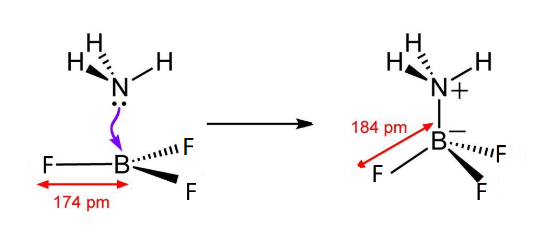
Answer
108k+ views
Hint: \[N{H_3}\] is electron rich as it has a lone pair and \[B{F_3}\] is electron deficient, due to this, ammonia donates its electron pair to \[B{F_3}\] , which has vacant orbital that takes up electrons and completes its octet by forming a coordinate bond and changing its hybridisation.
Complete step-by-step solution:
\[N{H_3}\] is an electron-rich species with a lone pair on a Nitrogen atom and so it is always ready to either share or donate this lone pair to other species. Therefore, it is known as a Lewis base. Lewis bases can donate a pair of non-bonding electrons.
While, \[B{F_3}\] is an electron-deficient species having vacant orbitals with an incomplete octet of Boron. So \[B{F_3}\] always looks for species which can donate electrons to it and complete its octet. Therefore, it is known as Lewis acid. These are electron acceptors.
So, when they come close to each other to form a bond, an ammonia molecule coordinates its lone pair to the empty p-shell or vacant p-orbitals of Boron forming a co-ordinate bond to give rise to an adduct which looks like this.

\[B{F_3}\] has a hybridisation of \[s{p^2}\] because of filling of 2s and 2 orbitals of 2p. But as it forms coordinate bond with ammonia, the lone pair accepted from ammonia leads to bond pair and lone pair repulsion, changing its shape from trigonal planar to tetrahedral and hybridisation from \[s{p^2}\] to \[s{p^3}\] due to filling of one more 2p orbital. This makes the system highly stable by removing the electron deficiency of boron.
Hence, the correct option is (B).
Note: As per molecular orbital theory, one can also understand this concept as the HOMO on the Lewis base (\[N{H_3}\]) interacts with the electron pair in the LUMO of the Lewis acid (\[B{F_3}\]). This forms an adduct of these molecular orbitals and lowers the energy by stabilizing it.
Complete step-by-step solution:
\[N{H_3}\] is an electron-rich species with a lone pair on a Nitrogen atom and so it is always ready to either share or donate this lone pair to other species. Therefore, it is known as a Lewis base. Lewis bases can donate a pair of non-bonding electrons.
While, \[B{F_3}\] is an electron-deficient species having vacant orbitals with an incomplete octet of Boron. So \[B{F_3}\] always looks for species which can donate electrons to it and complete its octet. Therefore, it is known as Lewis acid. These are electron acceptors.
So, when they come close to each other to form a bond, an ammonia molecule coordinates its lone pair to the empty p-shell or vacant p-orbitals of Boron forming a co-ordinate bond to give rise to an adduct which looks like this.

\[B{F_3}\] has a hybridisation of \[s{p^2}\] because of filling of 2s and 2 orbitals of 2p. But as it forms coordinate bond with ammonia, the lone pair accepted from ammonia leads to bond pair and lone pair repulsion, changing its shape from trigonal planar to tetrahedral and hybridisation from \[s{p^2}\] to \[s{p^3}\] due to filling of one more 2p orbital. This makes the system highly stable by removing the electron deficiency of boron.
Hence, the correct option is (B).
Note: As per molecular orbital theory, one can also understand this concept as the HOMO on the Lewis base (\[N{H_3}\]) interacts with the electron pair in the LUMO of the Lewis acid (\[B{F_3}\]). This forms an adduct of these molecular orbitals and lowers the energy by stabilizing it.
Recently Updated Pages
If x is real then the maximum and minimum values of class 10 maths JEE_Main

If one of the roots of equation x2+ax+30 is 3 and one class 10 maths JEE_Main

The HCF of two numbers is 96 and their LCM is 1296 class 10 maths JEE_Main

The height of a cone is 21 cm Find the area of the class 10 maths JEE_Main

In a family each daughter has the same number of brothers class 10 maths JEE_Main

If the vertices of a triangle are ab cc b0 and b0c class 10 maths JEE_Main

Other Pages
Lattice energy of an ionic compound depends upon A class 11 chemistry JEE_Main

A 5m long pole of 3kg mass is placed against a smooth class 11 physics JEE_Main

If a wire of resistance R is stretched to double of class 12 physics JEE_Main

The graph of current versus time in a wire is given class 12 physics JEE_Main

Electric field due to uniformly charged sphere class 12 physics JEE_Main

As a result of isobaric heating Delta T 72K one mole class 11 physics JEE_Main




